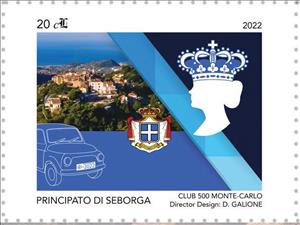Stamp: View of Seborga, Fiat 500 and Princess Nina (Cinderellas 2022)
View of Seborga, Fiat 500 and Princess Nina (Cinderellas 2022)
20 August (Cinderellas ) within release Italy : Principality of Seborga goes into circulation Stamp View of Seborga, Fiat 500 and Princess Nina face value 20 Seborgan cent
| Stamp View of Seborga, Fiat 500 and Princess Nina in catalogues | |
|---|---|
| Colnect codes: | Col: IT-SB 2022-01/5 |
Stamp is square format.
Stamp from mini sheetAlso in the issue Italy : Principality of Seborga:
- Stamp - Bee face value 20;
- Stamp - Black tomato face value 20;
- Stamp - Boar face value 20;
- Stamp - Broom face value 20;
- Stamp - Church of San Bernardo face value 20;
- Stamp - Church of San Martino face value 20;
- Stamp - Coat of arms of the Principality face value 20;
- Stamp - Flag of the Principality face value 20;
- Mini Sheet - Flora, fauna and food S/S face value 9*20;
- Stamp - Guards face value 20;
- Stamp - Knights Templar face value 20;
- Stamp - Knights Templar face value 20;
- Stamp - Luigino coin, 1669 face value 20;
- Stamp - Luigino coin, 2021 face value 20;
- Stamp - Mimosa face value 20;
- Stamp - Nina Menegatto (1978-), Princess of Seborga face value 20;
- Stamp - Nina Menegatto (1978-), Princess of Seborga face value 20;
- Stamp - Olive tree face value 20;
- Stamp - Pastel drawing of Piazza della Libertà face value 20;
- Stamp - Pastel drawing of Piazza della Libertà face value 20;
- Stamp - Pesto face value 20;
- Stamp - Taggiasco oil face value 20;
- Stamp - View of Seborga face value 20;
- Stamp - View of Seborga, Fiat 500 and Princess Nina face value 20;
- Mini Sheet - Views from the Principality of Seborga S/S face value 6*20;
- Mini Sheet - Views from the Principality of Seborga S/S face value 9*20;
- Stamp - Wild rabbit face value 20;
|
Data entry completed
50%
|
|
|---|---|
| Stamp View of Seborga, Fiat 500 and Princess Nina in digits | |
| Country: | Cinderellas |
| Date: | 2022-08-20 |
| Emission: | Cinderella |
| Format: | Stamp |
| Face Value: | 20 Seborgan cent |
Stamp View of Seborga, Fiat 500 and Princess Nina it reflects the thematic directions:
A car is a wheeled, self-powered motor vehicle used for transportation and a product of the automotive industry. Most definitions of the term specify that cars are designed to run primarily on roads, to have seating for one to eight people, to typically have four wheels with tyres, and to be constructed principally for the transport of people rather than goods. The year 1886 is regarded as the birth year of the modern car. In that year, German inventor Karl Benz built the Benz Patent-Motorwagen. Cars did not become widely available until the early 20th century. One of the first cars that was accessible to the masses was the 1908 Model T, an American car manufactured by the Ford Motor Company. Cars were rapidly adopted in the United States of America, where they replaced animal-drawn carriages and carts, but took much longer to be accepted in Western Europe and other parts of the world.
A coat of arms is an heraldic visual design on an escutcheon (i.e. shield), surcoat, or tabard. The coat of arms on an escutcheon forms the central element of the full heraldic achievement which in its whole consists of shield, supporters, crest, and motto. A coat of arms is traditionally unique to an individual person, family (except in the United Kingdom), state, organisation or corporation.
In British heraldry, a coronet is any crown whose bearer is less than sovereign or royal in rank, irrespective of the crown's appearance. In other languages, this distinction is not made, and usually the same word for crown is used irrespective of rank (German: Krone, Dutch: Kroon, Swedish: Krona, French: Couronne, etc.) In this use, the English coronet is a purely technical term for all heraldic images of crowns not used by a sovereign, and implies nothing about the actual shape of the crown depicted. A Coronet is another type of crown, but is reserved for the lower ranks of nobility like Marquesses and Marchionesses, Earls and Countesses, Barons and Baronesses, and some Lords and Ladies. The specific design and attributes of the crown or coronet signifies the hierarchy and ranking of its owner.
A woman is an adult female human. Before adulthood, a woman is referred to as a girl (a female child or adolescent)




